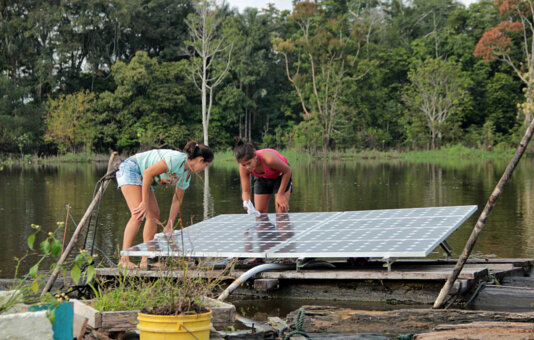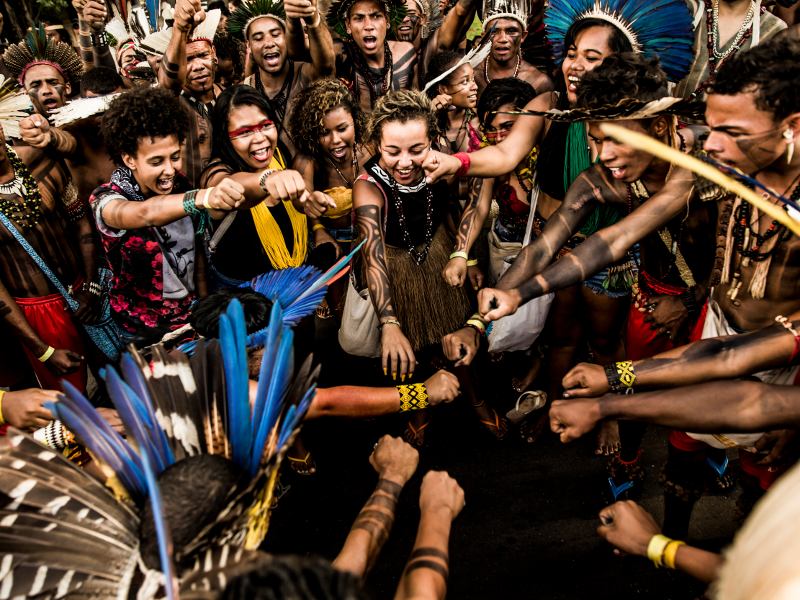- About
- Topics
- Picks
- Audio
- Story
- In-Depth
- Opinion
- News
- Donate
-
Signup for our newsletterOur Editors' Best Picks.Send
Read, Debate: Engage.
| April 05, 2022 | |
|---|---|
| topic: | Renewables |
| tags: | #Amazon, #indigenous people, #water, #solar power, #Amazonia |
| located: | Brazil |
| by: | Ellen Nemitz |
FairPlanet visited the reserve in early March 2022. There, we met Claudia, a woman who lives in Boca do Mamirauá with her family and, among other things, sells handicraft for tourists staying at the community-based lodge Uakari (FairPlanet’s trip has not been sponsored by Ukarai).
Claudia says that having running water spared her from having to wash clothes on the banks of the river, something that many women in the region still do. With more available time, she could even assume a role in the lodge, work for tourists and earn more money and independence.
Civil engineer Rafaela Dias Lopes, who works at the Mamirauá Institute and participated in the installation of the water treatment system in another community called Caburini, told FairPlanet about this paradoxical relation of people who live surrounded by water - tailoring their lives to the cycles of the river, whose depth varies 10 metres annually on average between the rainy and dry seasons - but still struggle to access it.
"It is not only the potable water that is hard to find. During the dry season, women and children must walk long distances to reach the banks of the river and carry water to their houses in buckets for daily consumption, which is exhausting," Dias Lopes said, mentioning that those who live in palafitas (elevated houses located metres above the ground) face more difficulties than those living in floating houses. "The longest distance we found was one kilometre, and when the river starts to rise the sand becomes mud, making the walk even harder."
Among the achievements observed in communities granted water treatment systems are the empowerment of women, improved health and a decreased risk of small children drowning at the river's edge.
The pumping systems use solar power cells installed on floating wooden rafts and, in order to disinfect the river water collected, ecologic filters made up of vanes or plastic bottles filled with sand, rocks, cotton and other natural materials. "We encourage them to keep collecting rain water, because it is much easier to filter it than the river's," Dias Lopes explained.
The projects carried out by the Mamirauá Institute involved the local communities throughout their implementation and maintenance processes, and thus made them more connected and aware of the significance of clean water. Women are, according to Dias Lopes, generally make up the sole demographic during the workshops. "If you ask a man what changed with the innovation, they will answer you that it improved women's lives. But women will ask: 'don't men drink water too?'."
Environmental engineer Leonardo Capeleto de Andrade, a researcher at the Mamirauá Sustainable Development Institute in the area of Water Treatment for Amazonian riverside communities, also highlights the importance of education. It is sometimes hard to explain, he says, how crucial treating water is. The water collected directly from the river is assumed to be pure by some people, and it is necessary to explain to them that the water may contain microorganisms that could be harmful to their health.
Despite the efforts carried out by Mamirauá Institute over the past two decades, the projects were not always successful. The continuous follow-up and maintenance are as crucial as the setup, and there are reported cases in which misuse and mismanagement had led to the damage and loss of installed systems.
Another problem to be considered in a large number of communities is human feces - which can pose a threat to the environment as well as to peoples' health and safety if not treated properly. Usually, riverine communities use sinkholes to defecate, but these pits get submerged in water during flood season and contaminate the water.
Social technology to treat sewage is already available. A 2015 study by the Mamirauá Institute for Sustainable Sanitation, for instance, discovered a way to filter excrements by using a septic tank and an anaerobic filter and subsequently releasing non-contaminant residual water into the river. Currently in use by Uakari Lodge, the community-based business located in Mamirauá Reserve, the technology hass yet to be scaled.
The technologies implemented by Mamirauá Institute's researchers seems to be quite simple, at least when compared with those used by sanitation companies in large urban centres. Nonetheless, they demand many years of development and are expensive (one sole system can cost more than $10,000 and scaling them up makes for a multi-million dollar venture). These two factors, combined with the lack of political willingness to serve remote rural populations, hinder the task of materialising the human right of having clean-water access.
The riverines living within the Mamirauá Sustainable Reserve are, mostly, a population formed by indigenous peoples and former ‘rubber soldiers’ - men who came from other parts of Brazil, especially the northeast, to work on latex exploitation between 1879 and 1945. In the aftermath of the Amazon Rubber Boom, some of these so-called ‘rubber soldiers’ remained in the region and looked for other ways of sustenance. However, throughout the Amazon, a huge area spanning across over 5 million square metres in Brazil alone, there is a large variety of peoples, cultures and ways of living. What characterises them all - riverines and indigenous - is the connection to and interdependence on nature to survive.
The Brazilian Constitution grants all citizens the right to access clean water and sewage treatment in order to avoid diseases caused by open sewage and environmental contamination. A law that came into effect in 2007 also instructs the state to take special care of indigenous peoples and other traditional populations when it comes to clean water access and search for "solutions compatible with their sociocultural characteristics."
However, data from the Trata Brasil Institute - which should be taken with a grain of salt since the indicators are provided by the sanitation companies, which only account for areas they are contracted to operate in and not the ‘irregular’ ones - shows that around 84 percent of all Brazilians access potable water. When it comes to the northern region, however, where many indigenous and riverines live, this rate falls to less than 60 percent. "Even the biggest cities here do not have treated water, such as Tefé. It's just the supply," said engineer Leonardo Capeleto de Andrade.
Sewage treatment should also be universal, but around 100 million people across Brazil do not receive this service.
The Coordinator of the Quality of Life Program at the Mamirauá Institute, Maria Cecília Rosinski Lima Gomes, lists some reasons as to why it is still difficult to overcome these gaps. Firstly, she proposed, the technologies developed by researchers usually do not reach decision makers; better scientific divulgation would be necessary to bring positive results to society, she said.
Moreover, it is necessary to continuously invest in the improvement of the technologies once they are developed. "The technology that we use, for example, has been in continuous development for about 20 years, and there are still points to improve, even though it is already available to be applied," she explained.
Within Mamirauá's reserve, the teams look for funding and resources among city councillors and mayors, as well as companies and institutions which extend a certain amount of financial aid for select projects.
Another successful example was carried out by the Chico Mendes Memorial. The project "Sanear Amazônia: Social mobilisation towards water security for extractivist families in the Amazon" brought the social technologies of water and sewage treatment to at least 23 counties in four states (Amazonas, Pará, Amapá and Acre) between 2015 and 2018.
Nevertheless, many more people still need to be granted advances. "It lacks coordinated action of governments and institutions to make it happen. Many technologies reach people, but these are strict actions," added Maria Cecília Gomes. "Often, a governmental body provides the benefit, but there is no continuous follow-up. Thus, communities do not know what to do when facing problems, which leads to the discontinuation of the service."
The hindrances are in fact a reality in a country with continental dimensions and regions only reachable through long-distance travels by boat, for instance. Moreover, conditions imposed by nature, such as the flood cycles in floodplain regions, make the task harder. No obstacles, however, should serve as an excuse for the absence of a basic human right.
Image by Aline Fidelix/Mamirauá Institute
By copying the embed code below, you agree to adhere to our republishing guidelines.


